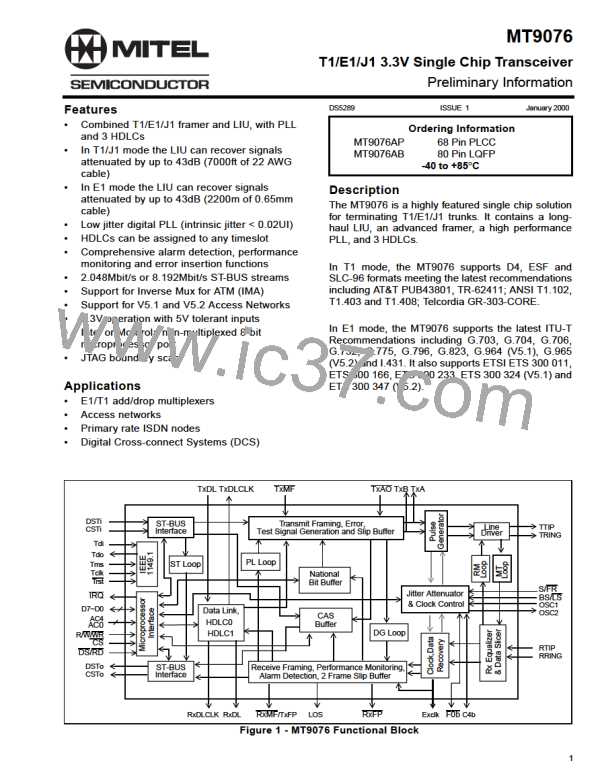MT9076
Preliminary Information
15.7
Transmit Message
When bit seven (TXMSG) in the Per Time Slot Control Word is set the data transmit in the selected channel is
sourced from the transmit message word in Master Control page 1.
16.0 Alarms
The following alarms are detected by the receiver in T1 mode. Each may generate a maskable interrupt:
•
D4 Yellow Alarm - in D4 mode there are two possible yellow alarm signals. If control bit D4SECY is set low,
(page 1H, address 11H, bit 1) the criteria for a yellow alarm is an excess of ’0’s (more than 285) in bit position
2 of incoming DS0 channels during an integration period of 1.5 milliseconds. It is cleared after more than 3 ’1’s
are detected in bit position 2 of normal data in a 1.5 millisecond integration period. If D4SECY is set high the
secondary yellow alarm is selected. The detection criteria becomes 2 consecutive ’1’s in the Sbit position of the
12th frame.
•
ESF Yellow Alarm - In ESF mode, there are two possible yellow alarm signals. If control bit JYEL (page 1H,
address 14H, bit 0) is set low the criteria for a yellow alarm is a pattern 00000000 11111111 in seven or more
code words out of ten, If JYEL is set high, the criteria for a yellow alarm is a pattern 11111111 11111111 in
seven or more code words out of ten.
•
•
All Ones - This bit (page 3H, address 11H, bit 3) is set if less than six zeros are received on the incoming line
data during a 3 ms interval
Loss of Signal - a loss of signal condition occurs when the receive signal level is lower than 20dB or 40 dB
below the nominal signal level for at least a millisecond or when 32 or 192 (control bit L32Z (page 01H, address
19H, bit 1) consecutive zeros have been received. A loss of signal condition will terminate when an average
ones density of at least 12.5% has been received over a period of 193 contiguous pulse positions starting with
a pulse. The loss of signal is reported in the Receive Signal Status Word - (page 3, address 16H bit 4).
The following alarms are detected by the receiver in E1 mode. Each may generate a maskable interrupt:
•
•
Remote Alarm Indication (RAI) - bit 3 (A) of the receive NFAS;
Alarm Indication Signal (AIS) - unframed all ones signal for at least a double frame (512 bits) or two double
frames (1024 bits);
•
•
•
Channel 16 Alarm Indication Signal - all ones signal in channel 16;
Auxiliary pattern - 101010... pattern for at least 512 bits;
Loss of Signal - a loss of signal condition occurs when the receive signal level is lower than 20dB or 40 dB (by
setting the bit ELOS on page 02H, address 10H, bit 3) below the nominal signal level for more than a
millisecond or when more than 32 or 192 (control bit L32Z (page 01H, address 19H 9 bit 1) zeros have been
received in a row. A loss of signal condition will terminate when an average ones density of at least 12.5% has
been received over a period of 192 contiguous pulse positions starting with a pulse.
•
Remote signaling Multiframe Alarm - (Y-bit) of the multiframe alignment signal.
The alarm reporting latch (address 12H page 04H) contains a register whose bits are set high for selected
alarms. These bits stay high until the register is read. This allows the controller to record intermittent or
sporadic alarm occurances.
16.1
Automatic Alarms
In E1 mode, the transmission of RAI and signaling multiframe alarms can be made to function automatically
from control bits ARAI and AUTY (page 01H, address 10H). When ARAI = 0 and basic frame synchronization is
lost (SYNC = 1), the MT9076 will automatically transmit the RAI alarm signal to the far end of the link. The
transmission of this alarm signal will cease when basic frame alignment is acquired.
When AUTY = 0 and signaling multiframe alignment is not acquired (MFSYNC = 1), the MT9076 will
automatically transmit the multiframe alarm (Y-bit) signal to the far end of the link. This transmission will cease
when signaling multiframe alignment is acquired.
54

 MITEL [ MITEL NETWORKS CORPORATION ]
MITEL [ MITEL NETWORKS CORPORATION ]